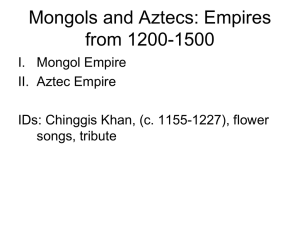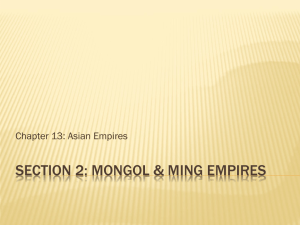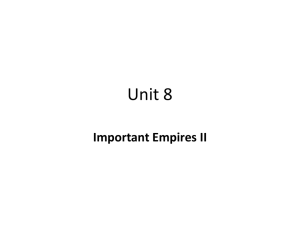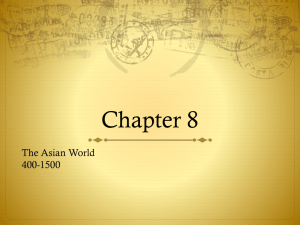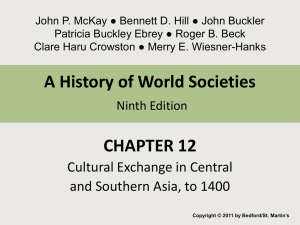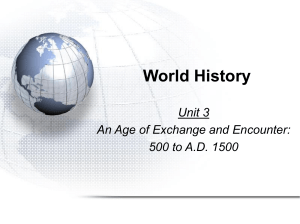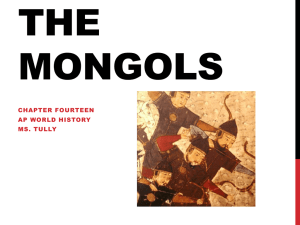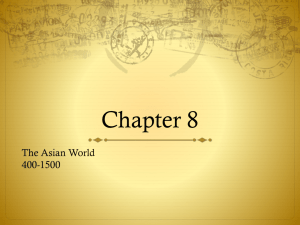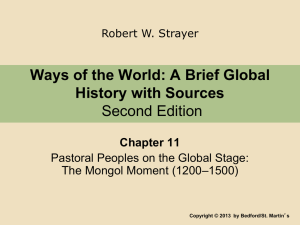Eastern Asian Civilizations
advertisement
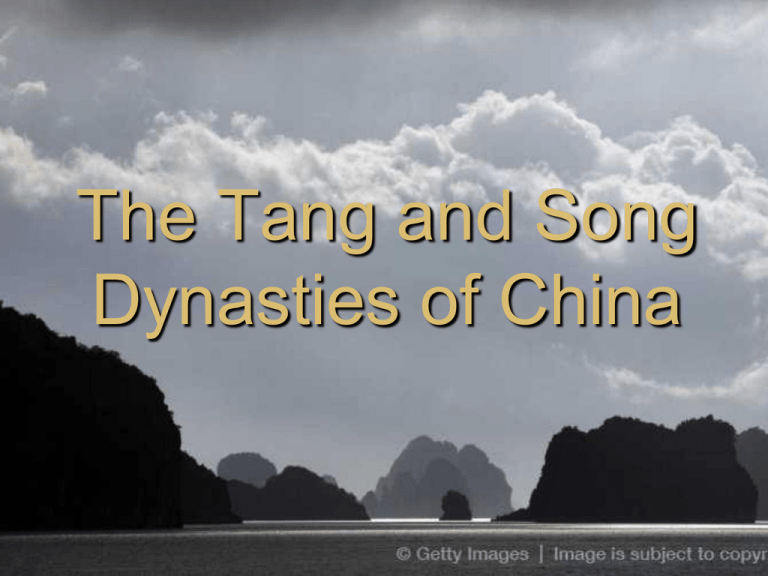
The Tang and Song Dynasties of China China experienced a similar dark age as Europe had experienced after the fall of Rome This time is known as the Six Dynasties China emerged from this dark period to become one of the world’s leading civilizations under the Tang Dynasty Conquered Korea and Manchuria Tang Dynasty (618-907) The “Golden Age” of China Used their military to suppress peasant uprisings and to reunited China Empire had around 50 million people Expanded trade on the Silk Road with Persia, Arabia, Japan and the Byzantine Empire Tang Dynasty (618-907) Reintroduced a civil service system to find candidates for government office People took test to determine what position they could hold in public office Government built roads and public works projects Song Dynasty 960-1279 The Song Dynasty arose after the fall of the Tang Dynasty It was smaller then the Tang Empire They expanded on the achievements of the Tang Dynasty Song Dynasty 960-1279 First people to use paper currency (money) Used coins made of copper and iron Song Dynasty (960-1279) Eliminated forced labor Very large increase in farm production which led to greater wealth for China and it’s people Song Dynasty (960-1279) Inventions in Science and Technology The Compass Moveable type of printing Discovered that a magnetized needle floating in water will always point north Able to print at a faster rate Gunpowder First to use gunpowder in combat The Mongol Empire The Mongol Empire Central Asia Steppes- Treeless grasslands that stretch from Eastern Europe to Northeast Asia The Mongol Empire Nomadic people (roamed the grasslands without a permanent home) Developed excellent horsemanship and fierce fighting skills (archery) Lived in yurts- domed tents that could be easily moved The Mongol Empire Like most nomads they were divided in several loosely organized tribes Ghengis Khan united the tribes around 1206 Khan began a career of conquest by attacking neighboring people beyond Mongolia The Mongol Empire They faced very little resistance from outside forces 200,000+ skilled Mongol horsemen They had sturdy stirrups, strong bamboo bows and giant catapults Known for their fierce brutality, sometimes killing all defenders of a city if they refused to surrender The Mongol Empire Ghengis Khan was: Tolerant of other religions within the territories he conquered Promoted trade throughout the Mongol Empire Ordered the creation of a written Mongol language Leader of the largest empire the world had ever seen Stretched from the Black Sea in Europe to the Pacific Ocean The Mongol Empire Pax Mongolia: People could safely travel and trade from one end of the empire to the other The empire was so large it was divided into 4 separate kingdoms that were each ruled by Khan’s descendants The Mongol Empire: The Yuan Dynasty Kublai Khan: Genghis Khan’s grandson Born a Mongolian but was fascinated with Chinese Culture Reunited Northern and Southern China and encouraged Mongols to adapt Chinese ways The Mongol Empire: Marco Polo Merchant from Venice Journeyed along the Silk Road and visited China in the 1270’s He was astounded by Kublai Khan and the Mongol’s technological superiority over Europeans (used of gun powder and burning coal for heat) The Mongol Empire: Influence on Russia 13th century Mongol warriors conquered most of Russia Controlled it for nearly 200 years 1480: Ivan the Great declared Russia independent from Mongol Rule Mongol Empire: Notes Central Asia saw the rise of nomadic peoples who excelled at horsemanship and fighting skills During 1200, the Mongols of Central Asia established the world’s largest empire Ghengis Khan united Mongols and attacked China: promoted trade Kublai Khan: established the Yuan Dynasty in China and visited with Marco Polo Japan Very mountainous Protected by seas from foreign influences Early history Religion was important Believed in Gods and spirits called Kami Called Shinto Religion Emperors Modeled after Tang Art Science Government Fashion Feudal Japan Emperor was at top of chain Shogun Controversy Shoguns- Served emperor; Japanese ruling class Struggle for power, Ashikaga claimed authority for Shoguns Daimyo – local warlord, ranked below shogun Samurai – warrior class, served daimyo Peasants were lowest class Korea Korea’s history Three kingdoms emerged in opposition to Chinese rule Bridge from eastern Asia to neighboring island chains Korea was unified under the Silla Dynasty The growth of Korean culture Reflected many elements of Chinese culture Written language, Buddhism, civil service exams, dynasties Southeast Asia Cambodia, Laos, Malaysia, Myanmar, Thailand, Vietnam Vietnam influenced by China Mahayana Buddhism Other nations adopted both Chinese and Indian traditions Theraveda Buddhism Written languages - Sanskrit Architecture – Angkor Wat in Cambodia
